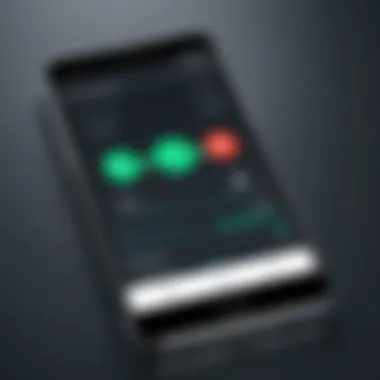A Comprehensive Guide on How to Find Your Lost Android for Free


Basic Steps to Retrieve Your Lost Android Device
Losing your Android device can be a stressful experience. However, with the right approach, you can locate your misplaced phone without incurring any costs. This comprehensive guide outlines the key steps you need to follow to find your lost Android device effortlessly. By adhering to these instructions, you can increase your chances of recovering your phone successfully without relying on expensive alternatives.
Activation of Find My Device Feature
The first and foremost step in locating your lost Android device is to activate the 'Find My Device' feature. This built-in functionality, provided by Google, enables you to track the location of your phone remotely. By turning on this feature before your device goes missing, you pave the way for a smoother retrieval process. It's vital to ensure that this feature is enabled on your device to leverage its tracking capabilities effectively.
Accessing Google's Find My Device Website
Once the 'Find My Device' feature is activated on your Android device, the next step involves accessing Google's dedicated website for tracking lost devices. By visiting the site on a web browser and logging in with the Google account linked to your lost phone, you can initiate the tracking process. This platform provides you with real-time information on the location of your device, helping you pinpoint its exact whereabouts.
Ring, Lock, and Erase Data Remotely
In addition to locating your lost Android device, the 'Find My Device' platform offers additional functionalities such as ringing the phone at maximum volume, locking the device remotely, and even erasing its data to prevent unauthorized access. These features enhance the security of your device while facilitating its retrieval. Depending on your specific needs, you can utilize these options to safeguard your data and maintain control over your lost phone.
Collaborating with Law Enforcement
If all efforts to retrieve your lost Android device prove futile, you can escalate the matter by contacting local law enforcement authorities. Providing them with relevant details, including the last known location of your device, its unique identifiers, and any additional information you deem necessary, can aid in the search process. Law enforcement agencies have the resources and capabilities to assist in locating lost devices, increasing the likelihood of recovery.
Prelims
The realm of losing one's Android device can be a realm of turmoil and distress for many individuals. In this comprehensive guide titled 'How to Find Your Lost Android for Free,' we aim to illuminate the path towards reuniting with your misplaced phone without incurring any expenses.. The significance of this topic lies in its ability to empower individuals with the means to navigate through the unsettling experience of losing a device that often holds a plethora of personal information, memories, and essential communication tools. By delving into the essence of this guide, readers can glean insights on efficient strategies that can lead to successful recovery.
Understanding the Situation
Realizing Your Android Device is Missing
One of the critical junctures in the tumult of losing an Android device is the moment of realization that it has gone astray. This pivotal point serves as the catalyst for initiating the recovery process. The key characteristic of fully grasping the absence of your Android device is its immediate impact on your daily routine and sense of security. Its prominence in this guide emanates from the fact that acknowledging the absence sets the wheels in motion for subsequent actions. Utilizing your presence of mind during this phase can significantly heighten the prospects of a successful retrieval. The unique feature of realizing the absence lies in its ability to trigger a proactive approach towards recovering your device, underscoring the importance of swift response and efficient decision-making.
Initial Steps to Take
Upon realizing the absence of your Android device, the initial steps taken play a critical role in shaping the outcome of the retrieval mission. This stage involves swift actions aimed at maximizing the chances of successfully locating the device. The primary characteristic of these initial steps is their role in laying down the foundation for the search operation. Engaging in systematic actions such as retracing your steps, reaching out to acquaintances, and employing built-in tracking features sets a solid groundwork for the subsequent phases. The advantage of these steps lies in their ability to expedite the recovery process by narrowing down potential locations and employing effective tracking techniques.
Importance of Prompt Action
Acting Quickly to Increase Chances of Recovery
The swiftness with which one responds to the loss of an Android device can significantly impact the success of its recovery. Acting promptly serves as a crucial element in the overarching goal of reuniting with your device swiftly and efficiently. The characteristic feature of swift action is its ability to prevent further complications or misuse of the lost device. By acting promptly, individuals enhance the chances of locating the device in its current vicinity before any substantial alterations occur. The advantage of prompt action lies in its pivotal role in preserving the integrity of the device's data and increasing the likelihood of a successful retrieval. Embracing this proactive approach sets a solid foundation for a streamlined and effective recovery mission.
Utilizing Built-in Features


In the realm of this comprehensive guide on locating your lost Android device for free, the focus shifts towards leveraging the built-in features that come embedded within the operating system. Unlike external applications, these features are intrinsic to the device, enhancing security and reliability without any additional costs. By tapping into these functionalities, users can significantly increase the chances of reclaiming their misplaced phones with ease.
When delving into Google's Find My Device, users are greeted with a potent tool for tracking and managing their Android devices seamlessly. It offers a plethora of utilities, including the ability to pinpoint the exact location of the phone on a map. Through this feature, users can visualize the device's coordinates, streamlining the retrieval process substantially.
Furthermore, the Remote Ring, Lock, and Erase Functions within Find My Device provide users with added layers of security and control. In scenarios where the device is inaccessible, users can remotely trigger a loud ring to locate it in nearby surroundings. Additionally, if the device poses a security risk, the option to lock or erase its data remotely ensures sensitive information remains safeguarded.
Transitioning to Samsung's Find My Mobile, users owning Samsung devices can access a tailored solution for locating their smartphones. This platform offers a user-friendly interface with functionalities optimized for Samsung's ecosystem. By utilizing this feature, users can enhance their chances of recovering their devices effectively.
Diving deeper into the Features Available for Samsung Devices, users are presented with a diverse set of capabilities curated for Samsung smartphone users explicitly. These features aim to streamline the tracking and recovery process for Samsung devices, ensuring a seamless experience. However, users must remain vigilant of the potential drawbacks that come with relying solely on this platform, balancing its advantages with its limitations.
Exploring Third-Party Options
In the realm of locating your lost Android device, delving into third-party options holds significant importance. These avenues present alternative methods to track and retrieve your phone beyond traditional built-in features. Exploring third-party apps provides users with a broader range of functionalities and tools that can enhance the chances of recovering a missing device. Additionally, these options offer a layer of customization and additional security features that may not be available through default tracking services.
Benefits and Risks
Advantages of Third-Party Apps
When considering the advantages of incorporating third-party applications into your search for a lost Android device, one notable aspect is the diverse set of features these apps offer. These can include real-time tracking, geofencing capabilities, and even the ability to capture photos remotely to identify potential thieves. Such versatility expands the scope of possibilities beyond basic tracking functions, increasing the likelihood of successful device retrieval. However, it's essential to note that while third-party apps offer advanced features, there may be potential compatibility issues with certain devices or operating systems, requiring thorough research before installation.


Security Considerations
Amid the benefits provided by third-party apps, security considerations stand out as a paramount factor. While these applications can bolster device recovery efforts, they may also pose risks related to data privacy and unauthorized access. Users must exercise caution when granting permissions to third-party apps, ensuring they do not compromise sensitive information in their pursuit to locate a lost device. Moreover, the reliance on external services for device tracking introduces additional vulnerabilities that could be exploited by malicious entities, highlighting the importance of selecting reputable and secure third-party solutions.
Popular Third-Party Apps
Features of Cerberus
Examining the functionalities of Cerberus, a prominent third-party app for Android device tracking, reveals an array of capabilities designed to streamline the recovery process. Among its standout features is the ability to remotely control the device, including locking and wiping data to prevent unauthorized access. Furthermore, Cerberus boasts advanced anti-theft tools such as SIM card change detection and stealth mode, offering comprehensive security measures to safeguard valuable information. Despite its robust feature set, users should remain cautious of potential system resources consumption due to Cerberus's active monitoring nature.
Using Where's My Droid
Integrating Where's My Droid into your arsenal of tracking solutions introduces a simplified yet effective approach to locating a missing Android device. This user-friendly app enables users to trigger the device's ringer remotely, aiding in identifying its location even in silent mode. Additionally, Where's My Droid facilitates GPS tracking with customizable settings for increased precision in determining the device's whereabouts. While offering straightforward functionality, users should be mindful of the app's reliance on location services, which may impact battery life over prolonged usage periods.
Additional Considerations
In this pivotal segment of the guide on locating your lost Android device, we delve into the critical aspects that go beyond the usual methods of retrieval. Additional Considerations serve as the final layer of defense against potential loss or theft, emphasizing proactive steps to safeguard your device and data. By addressing these considerations, users can fortify their Android devices against unforeseen circumstances, ensuring a higher chance of recovery in case of mishaps. This section acts as a roadmap for users to implement preventive measures and establish a safety net for their valuable devices and information.
Preventive Measures
Enabling Security Features in Advance
The cornerstone of device security, Enabling Security Features in Advance, plays a pivotal role in bolstering the overall safety of your Android device. By proactively activating essential security settings, such as passcodes, biometric authentication, and tracking tools, users can thwart unauthorized access and track their device's whereabouts in case of loss. This preemptive measure not only deters theft but also streamlines the recovery process, enabling swift action when faced with a missing device. The distinct advantage of Enabling Security Features in Advance lies in its proactive nature, allowing users to mitigate potential risks before they materialize. While the feature enhances device security, it also empowers users with control over their device's status, fostering a sense of confidence and preparedness.
Contacting Authorities
When all other avenues seem exhausted, Seeking Assistance from Law Enforcement emerges as a crucial step in the quest to retrieve a lost Android device. This facet underscores the importance of engaging legal channels to amplify recovery efforts and potentially track down the missing device. By involving authorities, users can tap into specialized resources and expertise, increasing the likelihood of a successful recovery mission. The key strength of Seeking Assistance from Law Enforcement lies in its formal approach towards device recovery, leveraging official support and procedures to aid in locating the device. While this route may involve certain bureaucratic hurdles, the benefits of expert guidance and legal intervention can significantly impact the outcome, offering a structured and organized framework for device retrieval.







